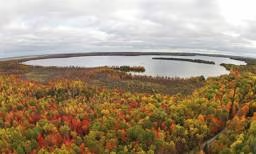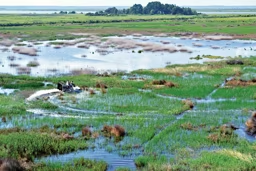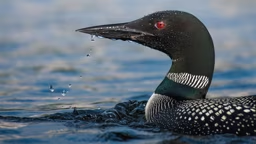But despite their ubiquitous nature, cattails are controversial.
Cattail controversy. Aside from their value as beautiful, graceful shoreline plants that can mesmerize you as they wave in the wind, cattails serve a number of functions in nature. Cattails – like other plants – filter runoff water, keeping lakes cleaner. Cattails also offer refuge to certain birds and animals that make their homes among the reeds.
A few cattails seem to be a good thing. But then sometimes there’s too much of a good thing.
Cattails can quickly reach nuisance levels, pushing out other aquatic plants that provide necessary food and shelter to some animals, and filling in shallow water areas, virtually replacing water with land. For some watershed managers and landowners on shallow lakes, ponds, rivers and streams, a battle rages to contain this plant’s expansive growth. How expansive? Accord-ing to Cornell University, cattails at the edge of pond can grow faster than fertilized corn in a field!
Where did it all begin? Historically, cattails were first reported in coastal wetlands along the Atlantic seaboard and Gulf coasts. Seeds transported on river barges and railroads spread the plant across the country. By the 1960s, cattails were the dominant wetland plant species forcing out the bulrushes previously found at the edges of lakes, ponds and slow-moving streams.
Covered in a dark brown velvet-like coating, the seed pods contain thousands of tiny seeds. After hungry birds pick away at the shell and expose the wispy white seeds, the wind takes it from there. When the seed pod bursts open, as many as 250,000 seeds can float away in the wind. Cattails also spread and grow by sprouting new plants through their root systems like other grass species.
Cattails rule the dividing line between water and land. Their tight matrix of stems traps biomass debris, which forms the beginning of soil and changes the landscape from wetland to thick nutrient-rich shore land. Over time, small shallow ponds and bogs can be completely filled in with cattails and other reeds.
The phenomenon of cattails transforming water to land doesn’t sit well with some landowners or watershed managers. Nor does the fact that as cattails take over wetland areas they push out plants favorable to ducks.
Many states and watershed districts discourage lake property and pond owners from allowing cattails to gain a foothold. Where cattails are established, efforts to curtail their growth have yielded mixed results.
Of course, eliminating cattails means evicting the types of wildlife that do call the reeds home.
Habitit. Reaching as high as 9 feet tall, the stands may be too dense for people to walk through but many birds and animals are right at home. While dense cattail stands are not hospitable for breeding ducks, birds including the small brown marsh wren and red-winged black bird build nests on the cattail stems. Muskrats and beaver feast on cattail roots and use the leaves and stems to build their dens.
In winter, cattail stems are sturdy enough to stand tall until spring returns. The cattail moth larvae hibernate in the cattail’s seed head. Open one up in the spring and you may find the silk left behind by the yellow and brown striped worms.
Cattails will certainly outlive us all, try as we might to control their growth. Love ’em or hate ’em, these tall sentinels rule the demarcation between land and water with a brand of grace and beauty only found in nature.
As a child, Lou Dzierzak thought cattails looked like corn dogs. But an attempt at eating a cattail seed pod during a Boy Scout camping trip proved they are very different.
 Cabin Life, Cabin Living
Cabin Life, Cabin Living 









